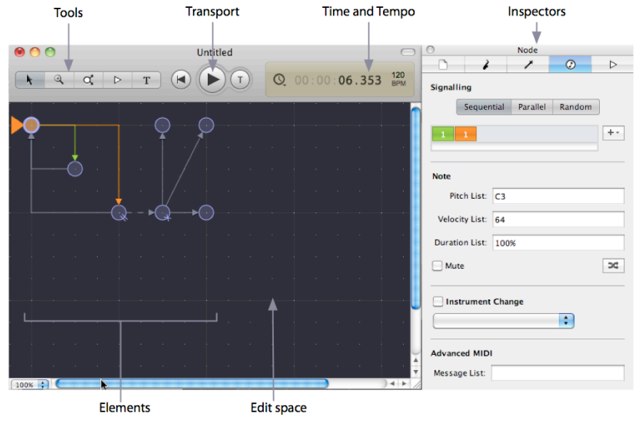What makes music software popular? Simple recording, DJ, and remix apps unsurprisingly do well. But perhaps as a testament to the importance of individual music expression, some stranger entries do, too. And those less-typical software creations can give you new ways of exploring music creation and performance. Just take Nodal.
GarageBand sits comfortably at the top of the sellers list on Apple’s App Store. But, at least briefly, a generative composition tool has rocketed to second place. Nodal 1.7, available for both Mac and Windows, is unlike most music production tools. In place of linear track arrangement, clusters of graphical nodes represent musical structure, awaiting real-time experimentation. In a network you create, “virtual players” produce patterns by traversing a geometric map defining pitch, rhythm, and sequence.
Nodal and tools like it have always been able to create musical machines from simple elements, letting the user define an arrangement and then set it in motion. But Nodal 1.7 is a major release in that it allows MIDI control, so that you can actually “play” the structure and not just sit back and let it roll.
This isn’t just for ambient music lovers, either – sync features mean you can use Nodal just as easily in rhythmic pieces or even dance music.

Developer Peter Mcilwain tells CDM:
We think new features make [Nodal 1.7] a serious composing tool. Firstly, it can be synced to other applications. Next, individual networks can be triggered (like clips in Ableton) from MIDI notes. The velocity levels in these networks can be scaled according to the velocity of the triggering note. Also, the edges or connections between nodes can now contain MIDI controller curves. This is all demonstrated in [the YouTube clip at top].
The triggering aspect means that you can perform with a generative system in a very intuitive way. Also, I have been working on a piece for a flute ensemble in which I create a triggering score in Logic. This information is then sent to Nodal. Nodal then sends back MIDI which is rendered and recorded in Logic. I’m finding this a fascinating and natural way to work.
Nodal has slipped a bit since Peter first contacted me, but seeing this among the top Mac App Store apps to me is tremendously satisfying. Peter tells us they’re not giving up their day jobs, but it’s nice just to get to support great software.
Nodal: Generative Music Software
I’d love to hear more about Nodal here, especially if you’re making interesting stuff with it. Of course, to discuss with other Nodal users, your best bet is the Nodal discussion group:
The development team – Jon McCormack, Alan Dorin, Aidan Lane, Jon McCormack and Peter McIlwain of Monash University’s Centre for Electronic Media Art in Australia – have published technical papers, too:
Nodal fans / users … or other folks doing development … we’d love to hear from you.
For more generative goodness, see also:
Intermorphic and Noatikl / Mixtilk, a cross-platform system that also includes mobile tools for iOS, from the same team that collaborated with Brian Eno and worked on the landmark SSEYO Koan system.
Hans Kuder’s Tiction uses graphical nodes as does Nodal, and, built in Processing, works on any OS (including Linux). Unfortunately, I’m not sure what happens to Hans or the tool; if anyone knows, let us know.
There are probably others I’m forgetting as the coffee settles in, so chime in in comments.